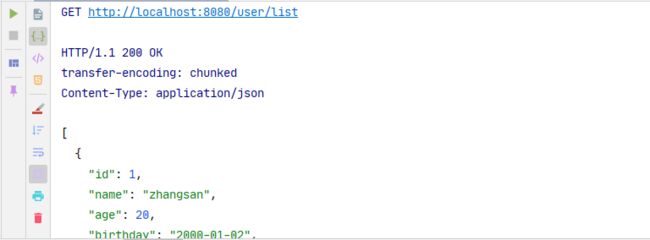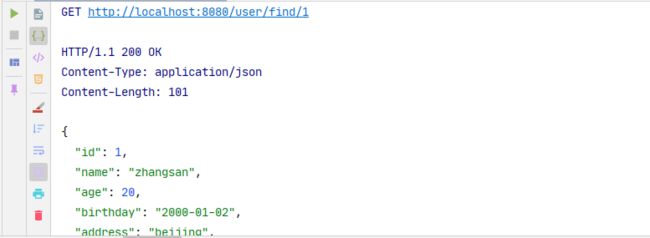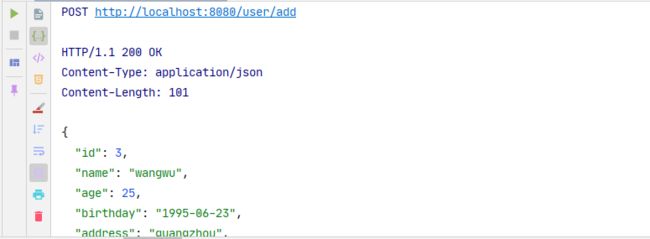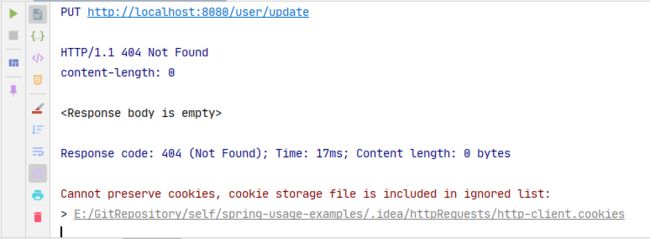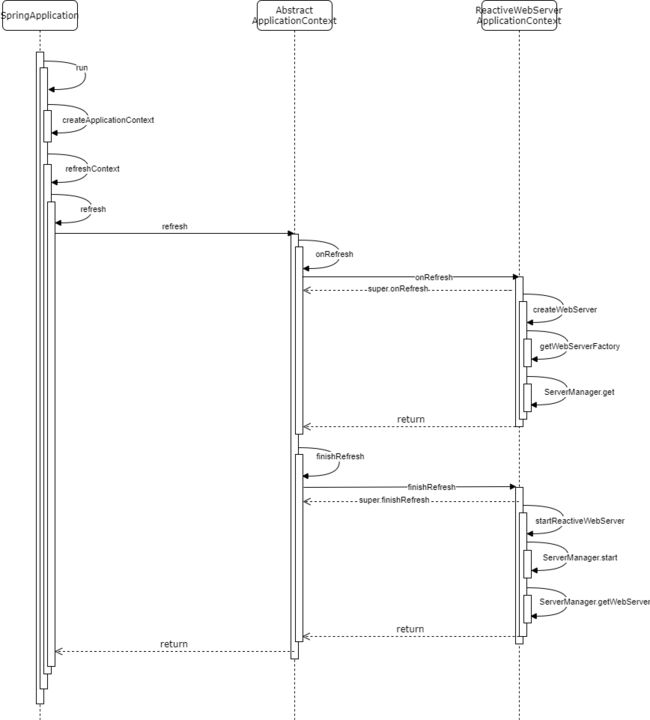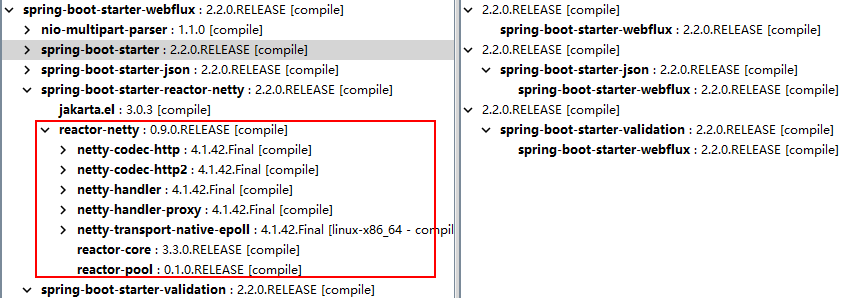1.简介
1.1 概述
In WebFlux.fn, an HTTP request is handled with a
HandlerFunction: a function that takesServerRequestand returns a delayedServerResponse(i.e.Mono). Both the request and the response object have immutable contracts that offer JDK 8-friendly access to the HTTP request and response.HandlerFunctionis the equivalent of the body of a@RequestMappingmethod in the annotation-based programming model.Incoming requests are routed to a handler function with a
RouterFunction: a function that takesServerRequestand returns a delayedHandlerFunction(i.e.Mono). When the router function matches, a handler function is returned; otherwise an empty Mono.RouterFunctionis the equivalent of a@RequestMappingannotation, but with the major difference that router functions provide not just data, but also behavior.
RouterFunctions.route()provides a router builder that facilitates the creation of routers, as the following example shows:
在WebFlux.fn中,HTTP请求由HandlerFunction处理:该函数接受ServerRequest并返回延迟的ServerResponse(即Mono )。请求和响应对象都具有不可变的协定,这些协定为JDK 8提供了对HTTP请求和响应的友好访问。 HandlerFunction等效于基于注释的编程模型中@RequestMapping方法的主体。传入的请求被路由到带有RouterFunction的处理程序函数:该函数接受ServerRequest并返回延迟的HandlerFunction(即Mono )。当路由器功能匹配时,返回处理程序功能。否则为空Mono。 RouterFunction等效于@RequestMapping批注,但主要区别在于路由器功能不仅提供数据,而且还提供行为。 RouterFunctions.route() 提供了一个路由器构建器,可简化路由器的创建过程。
1.2 特点
Router functions are used to route the requests to the corresponding
HandlerFunction. Typically, you do not write router functions yourself, but rather use a method on theRouterFunctionsutility class to create one.RouterFunctions.route()(no parameters) provides you with a fluent builder for creating a router function, whereasRouterFunctions.route(RequestPredicate, HandlerFunction)offers a direct way to create a router.Generally, it is recommended to use the
route()builder, as it provides convenient short-cuts for typical mapping scenarios without requiring hard-to-discover static imports. For instance, the router function builder offers the methodGET(String, HandlerFunction)to create a mapping for GET requests; andPOST(String, HandlerFunction)for POSTs.Besides HTTP method-based mapping, the route builder offers a way to introduce additional predicates when mapping to requests. For each HTTP method there is an overloaded variant that takes a
RequestPredicateas a parameter, though which additional constraints can be expressed.
路由器功能用于将请求路由到相应的HandlerFunction。通常,您不是自己编写路由器功能,而是使用RouterFunctions实用程序类上的方法创建一个。 RouterFunctions.route()(无参数)为您提供了一个流畅的生成器来创建路由器功能,而RouterFunctions.route(RequestPredicate,HandlerFunction)提供了直接创建路由器的方法。通常,建议使用route()构建器,因为它为典型的映射方案提供了便捷的捷径,而无需发现静态导入。例如,路由器功能构建器提供了GET(String,HandlerFunction)方法来为GET请求创建映射。和POST(String,HandlerFunction)进行POST。除了基于HTTP方法的映射外,路由构建器还提供了一种在映射到请求时引入其他谓词的方法。对于每个HTTP方法,都有一个以RequestPredicate作为参数的重载变体,尽管可以表达其他约束。
2.演示环境
- JDK 1.8.0_201
- Spring Boot 2.2.0.RELEASE
- 构建工具(apache maven 3.6.3)
- 开发工具(IntelliJ IDEA )
3.演示代码
3.1 代码说明
使用 RouterFunction 的方式使用 webflux
3.2 代码结构
3.3 maven 依赖
org.springframework.boot
spring-boot-starter-webflux
3.4 配置文件
无配置
3.5 java代码
UserModel.java
public class UserModel {
private Long id;
private String name;
private Integer age;
private String birthday;
private String address;
private String phone;
public UserModel() {}
public UserModel(Long id, String name, Integer age, String birthday, String address, String phone) {
this.id = id;
this.name = name;
this.age = age;
this.birthday = birthday;
this.address = address;
this.phone = phone;
}
// get&set&toString
}
UserRepository.java
@Repository
public class UserRepository {
// 预置两条数据,所以起始值从2开始
private static final AtomicLong ID_GENERATOR = new AtomicLong(2);
// 模拟数据库操作
private static final Map USER_MAP = new HashMap<>();
@PostConstruct
public void init() {
UserModel user1 = new UserModel(1L, "zhangsan", 20, "2000-01-02", "beijing", "13666666666");
UserModel user2 = new UserModel(2L, "lisi", 30, "1990-03-23", "shanghai", "13888888888");
USER_MAP.put(user1.getId(), user1);
USER_MAP.put(user2.getId(), user2);
}
public List findAll() {
return new ArrayList<>(USER_MAP.values());
}
public UserModel findById(Long id) {
return USER_MAP.get(id);
}
public UserModel add(UserModel userModel) {
long id = ID_GENERATOR.incrementAndGet();
userModel.setId(id);
USER_MAP.put(id, userModel);
return userModel;
}
public UserModel update(UserModel userModel) {
USER_MAP.put(userModel.getId(), userModel);
return USER_MAP.get(userModel.getId());
}
public UserModel deleteById(Long id) {
UserModel userModel = USER_MAP.get(id);
USER_MAP.remove(id);
return userModel;
}
}
UserHandler.java
@Component
public class UserHandler {
@Autowired
private UserRepository userRepository;
public Mono list(ServerRequest request) {
// ServerResponse.ok().body(Flux.fromIterable(userRepository.findAll()), UserModel.class);
return ServerResponse.ok().body(Flux.fromStream(userRepository.findAll().stream()), UserModel.class);
}
public Mono findById(ServerRequest request) {
return Mono.justOrEmpty(userRepository.findById(Long.valueOf(request.pathVariable("id"))))
.flatMap(user -> ServerResponse.ok().body(Mono.just(user), UserModel.class))
.switchIfEmpty(ServerResponse.notFound().build()); // 输出 404 Not Found
}
public Mono add(ServerRequest request) {
return ServerResponse.ok().body(
request.bodyToMono(UserModel.class).flatMap(userModel -> Mono.just(userRepository.add(userModel))),
UserModel.class);
}
public Mono update(ServerRequest request) {
/*request.bodyToMono(UserModel.class)
.flatMap(user -> Mono.justOrEmpty(userRepository.findById(user.getId()))
.then(ServerResponse.ok().body(Mono.just(userRepository.update(user)), UserModel.class))
// .switchIfEmpty(Mono.error(new NotFoundException(String.valueOf(user.getId())))))
.switchIfEmpty(ServerResponse.notFound().build()));*/
return request.bodyToMono(UserModel.class)
.flatMap(body -> Mono.justOrEmpty(userRepository.findById(body.getId())).flatMap(foundUser -> {
foundUser.setAge(body.getAge());
foundUser.setName(body.getName());
foundUser.setBirthday(body.getBirthday());
foundUser.setAddress(body.getAddress());
foundUser.setPhone(body.getPhone());
return Mono.just(foundUser);
}).flatMap(u -> ServerResponse.ok().body(fromObject(u))).switchIfEmpty(ServerResponse.notFound().build()));
}
public Mono deleteById(ServerRequest request) {
Long id = Long.valueOf(request.pathVariable("id"));
return Mono.justOrEmpty(userRepository.findById(id))
.switchIfEmpty(Mono.error(new RuntimeException(id + "not found!"))) // 控制台异常:RuntimeException: 30
.then(ServerResponse.ok().body(Mono.justOrEmpty(userRepository.deleteById(id)), UserModel.class));
}
public Mono deleteId(ServerRequest request) {
Long id = Long.valueOf(request.pathVariable("id"));
return Mono.justOrEmpty(userRepository.findById(id))
.flatMap(user -> ServerResponse.ok().body(Mono.just(userRepository.deleteById(id)), UserModel.class))
.switchIfEmpty(ServerResponse.notFound().build());
}
}
UserRouter.java
import static org.springframework.web.reactive.function.server.RequestPredicates.DELETE;
import static org.springframework.web.reactive.function.server.RequestPredicates.GET;
import static org.springframework.web.reactive.function.server.RequestPredicates.POST;
import static org.springframework.web.reactive.function.server.RequestPredicates.PUT;
import static org.springframework.web.reactive.function.server.RequestPredicates.accept;
import static org.springframework.web.reactive.function.server.RequestPredicates.contentType;
import static org.springframework.web.reactive.function.server.RouterFunctions.route;
import org.springframework.beans.factory.annotation.Autowired;
import org.springframework.context.annotation.Bean;
import org.springframework.context.annotation.Configuration;
import org.springframework.http.MediaType;
import org.springframework.web.reactive.function.server.RouterFunction;
import org.springframework.web.reactive.function.server.ServerResponse;
@Configuration
public class UserRouter {
@Autowired
private UserHandler userHandler;
@Bean
public RouterFunction routerFunction() {
return route(GET("/user/list").and(accept(MediaType.APPLICATION_JSON)), userHandler::list)
.andRoute(GET("/user/find/{id}").and(accept(MediaType.APPLICATION_JSON)), userHandler::findById)
.andRoute(POST("/user/add").and(contentType(MediaType.APPLICATION_JSON)), userHandler::add)
.andRoute(PUT("/user/update").and(contentType(MediaType.APPLICATION_JSON)), userHandler::update)
.andRoute(DELETE("/user/delete/{id}"), userHandler::deleteId);
}
}
3.6 git 地址
spring-boot/spring-boot-07-webflux/spring-boot-webflux-router
4.效果展示
启动 SpringBootWebfluxRouterApplication.main 方法,在 spring-boot-webflux-router.http 访问下列地址,观察输出信息是否符合预期。
查询用户列表
### GET /user/list
GET http://localhost:8080/user/list
Accept: application/json
根据id查询用户
### GET /user/find/{id}
GET http://localhost:8080/user/find/1
Accept: application/json
新增用户
### POST /user/add
POST http://localhost:8080/user/add
Accept: application/json
Content-Type: application/json
{
"name": "wangwu",
"age": 25,
"birthday": "1995-06-23",
"address": "guangzhou",
"phone": "13777777777"
}
更新用户(成功)
### PUT /user/update success
PUT http://localhost:8080/user/update
Accept: application/json
Content-Type: application/json
{
"id": 2,
"name": "lisi2",
"age": 32,
"birthday": "1988-03-23",
"address": "shanghai2",
"phone": "13888888882"
}
更新用户(失败)
### PUT /user/update fail // 404 Not Found (id)
PUT http://localhost:8080/user/update
Accept: application/json
Content-Type: application/json
{
"id": 222,
"name": "lisi2",
"age": 32,
"birthday": "1988-03-23",
"address": "shanghai2",
"phone": "13888888882"
}
删除用户
### DELETE /user/delete/{id}
DELETE http://localhost:8080/user/delete/3
Accept: application/json
5.源码分析
5.1 Webflux Server 如何启动?
使用 webflux 时,默认的 applicationContext 为 AnnotationConfigReactiveWebServerApplicationContext
protected ConfigurableApplicationContext createApplicationContext() {
Class contextClass = this.applicationContextClass;
if (contextClass == null) {
try {
switch (this.webApplicationType) {
case SERVLET:
contextClass = Class.forName(DEFAULT_SERVLET_WEB_CONTEXT_CLASS);
break;
case REACTIVE:
contextClass = Class.forName(DEFAULT_REACTIVE_WEB_CONTEXT_CLASS);
break;
default:
contextClass = Class.forName(DEFAULT_CONTEXT_CLASS);
}
}
catch (ClassNotFoundException ex) {
throw new IllegalStateException(
"Unable create a default ApplicationContext, please specify an ApplicationContextClass", ex);
}
}
return (ConfigurableApplicationContext) BeanUtils.instantiateClass(contextClass);
}
所以在 AnnotationConfigReactiveWebServerApplicationContext 中进行初始化和启动
5.2 Webflux 默认 Server 为何是 Netty?
先看下 spring-boot-starter-webflux 的依赖结构
在 spring-boot-autoconfigure/spring.factories 中有一个自动装配的类 ReactiveWebServerFactoryAutoConfiguration
它的内容如下
@AutoConfigureOrder(Ordered.HIGHEST_PRECEDENCE)
@Configuration(proxyBeanMethods = false)
@ConditionalOnClass(ReactiveHttpInputMessage.class)
@ConditionalOnWebApplication(type = ConditionalOnWebApplication.Type.REACTIVE)
@EnableConfigurationProperties(ServerProperties.class)
@Import({ ReactiveWebServerFactoryAutoConfiguration.BeanPostProcessorsRegistrar.class,
ReactiveWebServerFactoryConfiguration.EmbeddedTomcat.class,
ReactiveWebServerFactoryConfiguration.EmbeddedJetty.class,
ReactiveWebServerFactoryConfiguration.EmbeddedUndertow.class,
ReactiveWebServerFactoryConfiguration.EmbeddedNetty.class })
public class ReactiveWebServerFactoryAutoConfiguration {
@Bean
public ReactiveWebServerFactoryCustomizer reactiveWebServerFactoryCustomizer(ServerProperties serverProperties) {
return new ReactiveWebServerFactoryCustomizer(serverProperties);
}
@Bean
@ConditionalOnClass(name = "org.apache.catalina.startup.Tomcat")
public TomcatReactiveWebServerFactoryCustomizer tomcatReactiveWebServerFactoryCustomizer(
ServerProperties serverProperties) {
return new TomcatReactiveWebServerFactoryCustomizer(serverProperties);
}
@Bean
@ConditionalOnMissingBean
@ConditionalOnProperty(value = "server.forward-headers-strategy", havingValue = "framework")
public ForwardedHeaderTransformer forwardedHeaderTransformer() {
return new ForwardedHeaderTransformer();
}
/**
* Registers a {@link WebServerFactoryCustomizerBeanPostProcessor}. Registered via
* {@link ImportBeanDefinitionRegistrar} for early registration.
*/
public static class BeanPostProcessorsRegistrar implements ImportBeanDefinitionRegistrar, BeanFactoryAware {
private ConfigurableListableBeanFactory beanFactory;
@Override
public void setBeanFactory(BeanFactory beanFactory) throws BeansException {
if (beanFactory instanceof ConfigurableListableBeanFactory) {
this.beanFactory = (ConfigurableListableBeanFactory) beanFactory;
}
}
@Override
public void registerBeanDefinitions(AnnotationMetadata importingClassMetadata, BeanDefinitionRegistry registry) {
if (this.beanFactory == null) {
return;
}
registerSyntheticBeanIfMissing(registry, "webServerFactoryCustomizerBeanPostProcessor",
WebServerFactoryCustomizerBeanPostProcessor.class);
}
private void registerSyntheticBeanIfMissing(BeanDefinitionRegistry registry, String name, Class beanClass) {
if (ObjectUtils.isEmpty(this.beanFactory.getBeanNamesForType(beanClass, true, false))) {
RootBeanDefinition beanDefinition = new RootBeanDefinition(beanClass);
beanDefinition.setSynthetic(true);
registry.registerBeanDefinition(name, beanDefinition);
}
}
}
}
它里面通过 @Import 分别引入了 EmbeddedTomcat、EmbeddedJetty、EmbeddedUndertow、EmbeddedNetty,它们都是 ReactiveWebServerFactoryConfiguration 的内部类
abstract class ReactiveWebServerFactoryConfiguration {
@Configuration(proxyBeanMethods = false)
@ConditionalOnMissingBean(ReactiveWebServerFactory.class)
@ConditionalOnClass({ HttpServer.class })
static class EmbeddedNetty {
@Bean
@ConditionalOnMissingBean
ReactorResourceFactory reactorServerResourceFactory() {
return new ReactorResourceFactory();
}
@Bean
NettyReactiveWebServerFactory nettyReactiveWebServerFactory(ReactorResourceFactory resourceFactory,
ObjectProvider routes, ObjectProvider serverCustomizers) {
NettyReactiveWebServerFactory serverFactory = new NettyReactiveWebServerFactory();
serverFactory.setResourceFactory(resourceFactory);
routes.orderedStream().forEach(serverFactory::addRouteProviders);
serverFactory.getServerCustomizers().addAll(serverCustomizers.orderedStream().collect(Collectors.toList()));
return serverFactory;
}
}
@Configuration(proxyBeanMethods = false)
@ConditionalOnMissingBean(ReactiveWebServerFactory.class)
@ConditionalOnClass({ org.apache.catalina.startup.Tomcat.class })
static class EmbeddedTomcat {
@Bean
TomcatReactiveWebServerFactory tomcatReactiveWebServerFactory(
ObjectProvider connectorCustomizers,
ObjectProvider contextCustomizers,
ObjectProvider> protocolHandlerCustomizers) {
TomcatReactiveWebServerFactory factory = new TomcatReactiveWebServerFactory();
factory.getTomcatConnectorCustomizers()
.addAll(connectorCustomizers.orderedStream().collect(Collectors.toList()));
factory.getTomcatContextCustomizers()
.addAll(contextCustomizers.orderedStream().collect(Collectors.toList()));
factory.getTomcatProtocolHandlerCustomizers()
.addAll(protocolHandlerCustomizers.orderedStream().collect(Collectors.toList()));
return factory;
}
}
@Configuration(proxyBeanMethods = false)
@ConditionalOnMissingBean(ReactiveWebServerFactory.class)
@ConditionalOnClass({ org.eclipse.jetty.server.Server.class })
static class EmbeddedJetty {
@Bean
@ConditionalOnMissingBean
JettyResourceFactory jettyServerResourceFactory() {
return new JettyResourceFactory();
}
@Bean
JettyReactiveWebServerFactory jettyReactiveWebServerFactory(JettyResourceFactory resourceFactory,
ObjectProvider serverCustomizers) {
JettyReactiveWebServerFactory serverFactory = new JettyReactiveWebServerFactory();
serverFactory.getServerCustomizers().addAll(serverCustomizers.orderedStream().collect(Collectors.toList()));
serverFactory.setResourceFactory(resourceFactory);
return serverFactory;
}
}
@Configuration(proxyBeanMethods = false)
@ConditionalOnMissingBean(ReactiveWebServerFactory.class)
@ConditionalOnClass({ Undertow.class })
static class EmbeddedUndertow {
@Bean
UndertowReactiveWebServerFactory undertowReactiveWebServerFactory(
ObjectProvider builderCustomizers) {
UndertowReactiveWebServerFactory factory = new UndertowReactiveWebServerFactory();
factory.getBuilderCustomizers().addAll(builderCustomizers.orderedStream().collect(Collectors.toList()));
return factory;
}
}
}
它们生效的条件分别是:
- EmbeddedTomcat: @ConditionalOnClass -- Tomcat.class(apache)
- EmbeddedJetty: @ConditionalOnClass -- Server.class(jetty)
- EmbeddedUndertow: @ConditionalOnClass -- Undertow.class
- EmbeddedNetty: @ConditionalOnClass -- HttpServer.class
结合上面的依赖分析,spring-boot-starter-webflux 中依赖了 reactor-netty.jar,而 HttpServer.class 恰好在 reactor-netty.jar 包中,所以 netty 生效。最终使用 EmbeddedNetty 启动服务。
6.参考
- Spring Framework/WebFlux

